大学英汉、汉英翻译教程(卢红梅主编)思维导图
2024版考研英语翻译方法思维导图

考研英语翻译方法思维导图CONTENTS •introduction•Overview of English Translation Methods for Postgraduate Entrance Examination•The application of mind mapping in English translation forCONTENTS•Common errors and avoidance methods in English translation for postgraduate entrance exams•Practical Practice and Analysis of English Translation forintroduction01Cultivate translation thinking: Through learning and training, cultivate candidates' translationthinking, improve their sensitivity and expression ability to the English language.Improve the English translation ability of the postgraduate entrance examination: By learningand practicing various translation methods, improve the scoring ability of candidates in the English translation section of the postgraduate entrance examination.Response to exam requirements: Provide effective preparation strategies and methods for theEnglish translation section of the postgraduate entranceexamination, based on the exam requirements and scoring standards.Purpose and backgroundApplicable scopeGraduate English Exam CandidatesSuitable for all candidates taking the postgraduate English exam, especiallythose who need to achieve high scores in the translation section.English learnersIt also has certain reference value for English learners who hope to improve theirEnglish translation ability and language proficiency.Translation practitionersFor those engaged in translation work, practical translation methods and skillscan be provided to help them better complete translation tasks.Overview of English Translation Methods for Postgraduate Entrance02Literal translation methodWord translationPreserve the original words in the translation without violating the language norms of the original textand without causing erroneous associations.Structural transformationWhen the structure of English sentences is inconsistent with that of Chinese sentences, structuraltransformation is required to make the translation conform to Chinese expression habits.Omitting and supplementingAccording to Chinese expression habits, omit or supplement some redundant or missinginformation in the original text.Free translation methodWhen translating, pay attention to the fluency and readability of the translation to make it conform to Chinese expression habits.Keep the translation fluentWhen translating, the first step is to understand the deep meaning of the original text and the author's true intention.Understanding the meaning of the original textdon't stick to the words and structures of the original text, use words andstructures that conform to Chinese expression habits to express the original meaning.Get rid of the original formPersonal names, place names, brand names, and other proprietary terms: For such vocabulary, transliteration is generally used to express the original pronunciation in similar Chinese Some common vocabulary: In some cases, transliteration can also be used to enhance the readability and interest of the translation.Abbreviations and abbreviations: For suchvocabulary, transliteration can also be used toexpress the original pronunciation incorresponding Chinese characters. transliterationWhen translating, retain the image metaphors and rhetorical devices in the original text to make the translation more vivid and vivid.When the image in the originaltext cannot find a correspondingexpression in Chinese, themethod of image conversion canbe used to express the originalmeaning with an image thatconforms to Chinese expressionhabits.In some cases, in order to betterexpress the original meaning andenhance the expressive power ofthe translation, new imagemetaphors and rhetorical devicescan be created.Preserve the original image Image conversion Creating newimagesForm translation methodThe application of mind mapping in English translation for postgraduate03•Definition: A mind map is a graphical thinking tool that visualizes complex information and thinking processes through elements such as graphics, lines, and colors.characteristicVisualization: Using elements such as graphics and colors to make information more intuitive and easy to understand.Flexibility: Mind maps can be adjusted in structure and content as needed, making it easy for users to modify and improve. Structured: A mind map focuses on the central theme and radiates multiple sub themes outward, forming a clear hierarchical structure.Improving translation efficiency By using mind maps, one canquickly organize the structure of an article, locate key information, and improve translation speed and accuracy.要点一要点二Enhanced memoryeffectMind maps visualize important information and key points during the translation process, helping to deepen memory.Developing logical thinkingThe hierarchical structure of mind maps helps to cultivate the logical thinking ability of translators, making translation more accurate and fluent.要点三The advantages of mind mapping in translating English for postgraduate entrance examsHow to use mind maps to translate English for postgraduate entrance exams•Preparation: Familiarize oneself with the topic and backgroundknowledge of the article, understand relevant vocabulary andexpressions.•Create a mind map: Determine the central theme, which is the title orcore content of the article to be translated, and radiate multiple subthemes outward, including article structure, key information, importantvocabulary, etc.•Improve mind map: Gradually fill in each part of the mind mapaccording to the content of the article, add detailed information andrelated examples to make the mind map more rich and complete.•Using mind maps for translation: Based on the hierarchical structureand information prompts of mind maps, gradually translate to ensureaccuracy and fluency. At the same time, the mind map can be adjustedand improved at any time to adapt to changes in the translationprocess.Translation skills and strategies for postgraduate entrance examination04Carefully read the original text andunderstand the main idea and paragraphs of the article.Pay attention to the contextual meaning of vocabulary and avoid misinterpretation.Analyze sentence structure and grasp thelogical relationship between sentences.Understand the language styles of different literary genres, such as technology, literature,business, etc.9字9字9字9字Understand the original meaning and grasp the language styleChoose appropriate vocabulary and phrases to accurately express the original meaning.Use various sentence structures to make the translation more natural and fluent in expression.Pay attention to the collocation and usage of vocabulary, and avoid Chinglish.Maintain the coherence and consistency of the translation to avoid contradictions or repetition.Pay attention to selecting words and sentences, and maintain language fluency0102Omitting methodOmitting redundant or unnecessary information from the original text.Additional …Add necessaryvocabulary or phrases tomake the translationmore complete.TranslationmethodTransformingvocabulary or phrasesfrom the original textinto another form ofexpression.TranslationmethodSplit long sentencesinto multiple shortsentences to make thetranslation clearer andeasier to understand.Comprehensivemethodcomprehensively applythe above techniques tomake the translationmore accurate, fluent,and natural.030405Mastering translation skills to improve translation efficiencyCommon errors and avoidance methods in English translation for 0501 02 03Vocabulary errorsincluding confusion of word meanings, improper vocabulary combinations, etc.Grammar errorserrors in tense, voice, subject verb consistency, etc.Lack of cultural background knowledgeTranslation errors caused by lack of understanding of relevant cultural backgrounds.Common types of errorsError Cause AnalysisLack of solid language foundationInaccurate and proficient mastery of vocabulary and grammar.Lack of cultural background knowledgeInsufficient understanding of the cultural background in the relevant field.Improper translation skills and methodsLack of necessary translation skills and methods, resulting in low translationquality.Strengthen language basic training: improve vocabulary and grammar level, and enhance language perception ability.Expand culturalbackground knowledge:Widely read variousEnglish original works,newspapers andmagazines, etc., andaccumulate knowledge inrelated fields.Mastering translationskills and methods: Learnand master varioustranslation skills andmethods, such asaddition translation,omission translation,conversion method, etc.,to improve translationaccuracy and fluency.Do more practice andsimulation tests: Throughextensive practice andsimulation tests, improvetranslation speed andaccuracy, cultivatetranslation thinking andadaptability.Discussion on Avoidance MethodsPractical Practice and Analysis ofEnglish Translation for06•Review and Analysis of 2022 True QuestionsTitle OverviewTranslation difficulties and techniques Reference translation and rating•Review and Analysis of 2021 True QuestionsTitle OverviewTranslation difficulties and techniques Reference translation and rating•Trend analysis of past real test questionsReview and Analysis of Historical True Questions Change in question typeDistribution of examinationpointsDifficulty changesSimulated Question 1 Topic displayTranslation ideas guidance•Reference translation and self-evaluationSimulated Question 2Topic display Translation ideas guidance•Reference translation and self-evaluation•Simulated question threeTopic displayTranslation ideas guidanceReference translation and self-evaluationWord Meaning Selection Techniques Determine word meaning based on contextPay attention to the phenomenon of polysemy in a wordSentence structureanalysis techniquesIdentifyingsentencebackbone andmodifying Strategies for handling complex sentence patternsSkills for applying cultural background knowledge Understanding the culturaldifferences between Chinaand the WestProperly applyingbackground knowledge toassist translation谢谢您的聆听THANKS2024/1/2541。
新编英汉翻译教程第一章翻译概论ppt课件
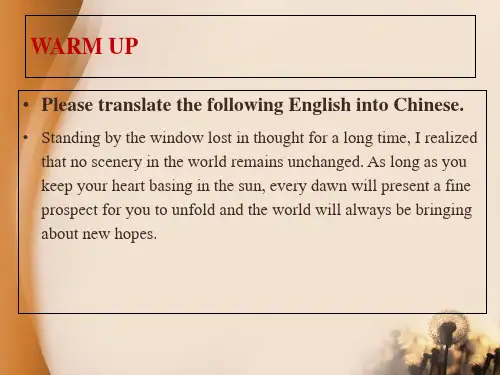
• 一个中学老师把KFC肯德基店里的广告标语“We do chicken right!”发给学生练习翻译,结果有如下答案:
•
01. 我们做鸡是对的!
•
02. 我们就是做鸡的!
•
03. 我们有做鸡的权利!
•
04. 我们只做鸡的右半边!
•
05. 我们只做右边的鸡!
“雪亮工程"是以区(县)、乡(镇) 、村( 社区) 三级综 治中心 为指挥 平台、 以综治 信息化 为支撑 、以网 格化管 理为基 础、以 公共安 全视频 监控联 网应用 为重点 的“群 众性治 安防控 工程” 。
“雪亮工程"是以区(县)、乡(镇) 、村( 社区) 三级综 治中心 为指挥 平台、 以综治 信息化 为支撑 、以网 格化管 理为基 础、以 公共安 全视频 监控联 网应用 为重点 的“群 众性治 安防控 工程” 。
Types of translation
• 3. According to styles (page 5) • 1) practical writings (应用文体)
English Dictionary • translation: the process of changing something that is written
or spoken into anther language. ----Oxford English Dictionary • Translating consists in reproducing in the receptor language
“雪亮工程"是以区(县)、乡(镇) 、村( 社区) 三级综 治中心 为指挥 平台、 以综治 信息化 为支撑 、以网 格化管 理为基 础、以 公共安 全视频 监控联 网应用 为重点 的“群 众性治 安防控 工程” 。
汉英翻译第一讲课程介绍学习策略概要
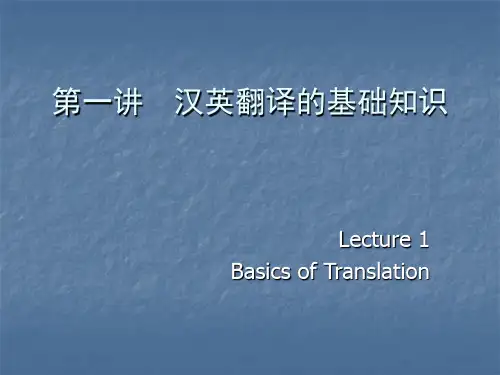
严复
(1854-1921) 字几道,晚号愈野老人,别 号尊疑,又署天演哲学家。中国近代资产阶级 启蒙思想家、翻译家、教育家。1877年作为首 批海军留学生入英国皇家海军学院学习,在英 国期间除学习海军专业外,还精心研读西方哲 学、社会政治学著作,并到英国法庭考察审判 过程,作中西异同比较。
than she:
的这一身惨绿色的贞女的道服,
Be not her maid, since she is envious; 它是只配给愚人穿的。那是我
Her vestal livery is but sick and green 的意中人;啊!那是我的爱;
And none but foo》英文编译委员会委员,中共中央对外联络部
毛选英文编译定稿小组成员。长期致力于中国和西方文学的研究。
主张用比较文学、心理学、单位观念史学、风格学、哲理意义学
等多学科的方法,从多种角度理解和评价文学作品。著有散文集
《写在人生边上》,短篇小说集《人•兽•鬼》,长篇小说《围
城》,选本《宋诗选注》。文论集《七缀集》、《谈艺录》及
选》、《西厢记》、《红与黑》、《包法利夫人》、《追忆似水
年华》等众多名著。
作品初览
作品初览
傅雷
(1908-1966),一代翻译巨匠。早年留学法国, 学习艺术理论,得以观摩世界级艺术大师的作 品,大大地提高了艺术修养。回国后曾任教于 上海美专,因不愿从流俗而闭门译书,几乎译 遍法国重要作家如伏尔泰、巴尔扎克、罗曼•罗 兰的重要作品。数百万言的译作成了中国译界 备受推崇的范文,形成了“傅雷体华文语言”。 60年代以后,傅雷以其研究与翻译巴尔扎克著 作的卓越成就,被吸引为法国巴尔扎克研究协 会会员。他多艺兼通,在绘画、音乐、文学等 方面,均显示出独特的高超的艺术鉴赏力。 1957年被打成“右派”,但仍坚持自己的立场。 “文革”中因不堪忍受污辱,与夫人朱梅馥双 双含冤自尽,实现了文格与人格的统一。
汉英翻译教程_课件_U2
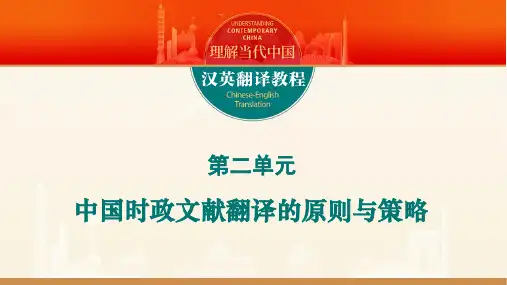
二、中国时政文献翻译策略
使用被动语态 具体语境下,可考虑将原文隐含主语句的宾语或相关内容调整为译文的主
语,形成被动语态,突出原文语义重点。 例. 党的十八大以来,➊我们坚持导向为魂、移动为先、内容为王、创新
为要,➋在体制机制、政策措施、流程管理、人才技术等方面加快融合步伐, ➌建立融合传播矩阵,➍打造融合产品,➎取得了积极成效。
二、中国时政文献翻译策略
• 人才强国战略 the strategy on developing a quality workforce • 建设制造强国 to build China into a manufacturer of quality • 加快建设人才强国 to step up efforts to make China a talent-strong country • 推进体育强国建设 to build China into a country strong in sport • 实现农业大国向农业强国跨越 to transform China from a country with high agricultural output to one with a leading edge in agriculture
• 爱国统一战线 patriotic united front • 社会主义核心价值观 the core socialist values • 中国特色社会主义 socialism with Chinese characteristics
二、中国时政文献翻译策略
中国时政文献经常借助隐喻修辞或生活化语言表达具体语义,语言风格 独特,语义鲜明,在具体语境下可考虑保留原文词语的语言特色,形象传达 原文思想内容,也可以归为对应式翻译策略。
《大学英汉翻译》课件
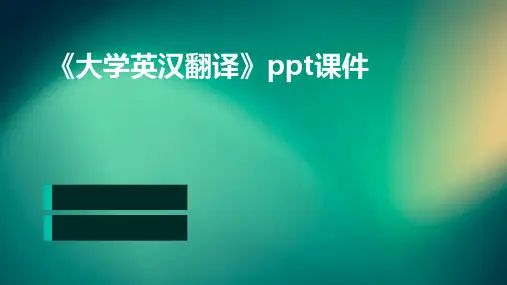
将理解后的意思用目标语言表达出来,注意语言的流畅性和准
确性。
校对
03
对译文进行校对和润色,确保译文的准确性和表达的流畅性。
02 英汉语言对比
词汇对比
总结词
词汇差异、词义对应、一词多义、词汇空缺
详细描述
英汉两种语言在词汇层面存在显著差异,一些英语词汇在汉语中没有直接对应的表达,反之亦然。在翻译过程中 ,需要深入理解词汇的内涵和外延,寻找最贴切的汉语表达。此外,一词多义和词汇空缺也是英汉翻译中常见的 现象,需要结合语境和专业知识进行准确翻译。
翻译的种类
包括口译、笔译、机器翻译 等。
翻译的标准
准确性
译文应准确传达原文的意思,避免歧义和误解 。
流畅性
译文应流畅自然,易于理解,符合目标语言的 表达习惯。
风格
译文应保持原文的风格和修辞特点,以传达原文的艺术效果。
翻译的过程
理解
01
准确理解原文的意思和语境,包括词汇、语法、文化背景等。
表达
02
《大学英汉翻译》ppt课件
目录
• 翻译概述 • 英汉语言对比 • 翻译技巧 • 翻译实践 • 翻译中的常见错误 • 翻译工具与资源
01 翻译概述
翻译的定义
ቤተ መጻሕፍቲ ባይዱ
翻译定义
翻译是将一种语言的信息用 另一种语言表达出来,以实 现跨语言沟通的过程。
翻译的本质
翻译不仅仅是语言的转换, 更是文化的传递和思想的交 流。
总结词
强调格式和行文规范
详细描述
商务翻译需遵循一定的格式和行文规范,符合商业信函、 合同、协议等文体的要求,用词规范、表达清晰,使译文 具有法律效力。
总结词
关注商业文化和谈判技巧
大学英语翻译教程 第五版 PPT第二讲
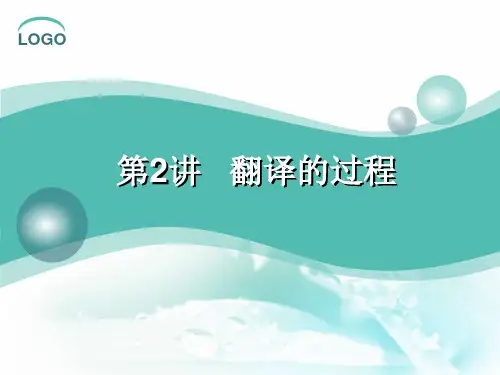
在英汉翻译的表达中应当着重注意的几 个原则性问题:
❖ 第三,表达中要遵循译文语言的习惯,努力避免“翻译腔”. 英译汉时,必须遵循汉语的表达习惯。只有这样,译文才能通顺 自然、明白晓畅,可读性强。也正是由于充分注意了这一点,下 面两例的译文才成为不留译痕的佳译:
(36) Although the recession has reached every corner of the planet, the impact is uneven.
2.2 妥帖表达
❖表达的好坏不仅取决于对原文的理解程度,而且 依赖于译者对译文语言的修养程度以及灵活运用 各种翻译方法与技巧的能力。假若语言使用不当、 表达方式欠妥,译文或词不达意或佶屈聱牙,正 确的理解也就难以在译文中体现出来。这正如以 下几例中的“原译”所示:
▪ (26) Susan stiffened, her face livid. ▪ 原译:苏珊变得僵硬了,脸色发青。
▪ 原译:斯特林投机倒把兜售紧俏商品。
▪ (32) Two days before he died, he talked about what he would have missed without the opportunity for a loving parting.
▪ 原译:他在死前两天谈到,如果不接受治疗,他就会错过 这些充满亲情的离别。
footsteps. ▪ 原译:厚厚的地毯消解了我的脚步声。 ▪ (30) Doctors cannot learn which persons face
the most danger until permanent hearing damage has been done. ▪ 原译:医生们无法知道,在永久性听觉损伤出 现之前,哪些人面临的危险最大。
翻译中的思维自由转换
汉英对比,思维的自由转换才是最高境界! 2016-12-22在学英语时要时时把它与汉语进行比较,形成两个“语言频道”,思维的自由转换才是更高的境界,切不可失落汉语这个中国人的“魂”。
——著名英语教育家、词典编纂家陆谷孙本文摘自:北京大学出版社出版的《汉英对比与英语》作者:张培成[师]咱们首先谈一谈英语词汇对比。
任何语言的学习中,词汇的学习都极为重要。
有两句关于词汇重要性的名言,你们学英语词汇学的时候想必看到“No matter how well the student learns grammar, no matter how 过。
一句是英国著名语言学家Michael McCarthy说的:successfully he masters the sounds of a L2, without words to express a wide range of meanings, communication in that language cannot happen in any meaningful way.”第二句是另一位英国著名语言学家D. Wilkins说的,这句话很多学英语的人都知道:“Without grammar, very little can be conveyed; without vocabulary, nothing can be conveyed.”[生]这些道理我们都明白,词汇量小的确是很严重的事情。
我觉得,有时候记单词几乎都成了学英语的代名词了。
有的同学单词量大一些,就会被认为英语学得好。
[师]单词量大还是小,不能光看能认得多少,关键要看能用多少。
能用就是在说英语、写英语和汉译英时能想起来,并知道该不该用,怎样用。
可是,现在很多同学以读单词、认单词为学习词汇的手段和目标,用的时候只是被动地在脑子里搜寻,想起什么来就说什么、写什么,而没有大量地、频繁地利用辞书等工具去主动学习如何使用词汇,只是被动反击,没有主动出击。
《考研英语》翻译方法思维导图
v 前加助动词 do
“的确,确实,务必,一一定,千万,真的”
疑问词后加the devil,the hell,on earth,in/under heaven
否定词/最高高级后加on earth
“到底,究竟”
It is +被强调部分 + that ...
被强调部分加“就是,正是,是” 若被强调部分本身就有强调语气气,不不必加
直译,在主句句前 补充说明条件,在主句句后
even if,no matter,for all that,granted that
直译,主句句前 表“省得,以免,生生怕...”,主句句后
直译,“结果”“如此 ... 以至至 于 ...” “没有 ... 不不 ...”,主句句中有否定词never,never so,not so,not such...,but that和but what 也可连接状从,构成双重否定
汉语无无冠词。大大多数泛指/专有
大大多数特指。“每个。这个,一一个...”
without saying a word → 一一句句挂不不说
译汉若在句句首首,大大多可省,句句尾,大大多不不省
系动词
与有动作含义的搭配的动词
重复法(突出强调)
其他重复法 重复 pron
原文文未重复,汉译重复
Please wait a moment → 请等一一等
it 作形宾
正常语序,it 不不译 将that引导宾从,提到句句首首
Kim replied that he was angry → Kim回答说,他生生气气了了
表语从句句 同位语从句句
从句句直接跟在名词后 从句句放在名词前,前置修饰,不不一一定加标记“的” 增加“即”“以为”,或冒号,破折号分开主从句句
英汉翻译讲义-第五章PPT课件
03
翻译技巧
选词技巧
确定词义
在翻译过程中,需要确定每个 英文单词的准确含义,特别是
那些具有多重含义的单词。
选择合适的词汇
根据上下文和语境选择最合适 的词汇进行翻译,确保译文准 确传达原文的意思。
注意词义的褒贬色彩
在翻译时需要注意英文单词的 褒贬色彩,确保译文的情感色 彩与原文一致。
考虑文化因素
在选词时需要考虑文化因素, 选择符合目标语言文化的词汇 ,避免产生文化冲突或误解。
翻译的过程
理解阶段
在翻译过程中,首先需要对原文 进行深入理解,包括语义、语境、
文化背景等方面的理解。
表达阶段
在理解原文的基础上,译者需要运 用目标语言的表达方式将原文的意 义、情感和风格传达出来。
校对阶段
完成初步翻译后,译者需要进行校 对工作,检查译文中的错别字、语 法错误、表达不流畅等问题,并进 行修正。
英汉翻译讲义-第五章
目 录
• 第五章导言 • 翻译理论 • 翻译技巧 • 实践与案例分析 • 总结与思考
01
第五章导言
章节概述
01
介绍英汉翻译的基本原 则和技巧,包括直译、 意译、音译等。
02
探讨英汉两种语言在词 汇、语法、句法等方面 的差异。
03
分析英汉翻译中的常见 问题,如词义选择、句 子结构调整等。
下章预告
• 第六章:翻译中的修辞手法与风格处理
感谢您的观看
THANKS
根据不同的分类标准,翻译可以分为 多种类型,如文学翻译、科技翻译、 商务翻译等。
翻译的标准
01
02
03
忠实于原文
译文应忠实于原文,准确 传达原文的意义、情感和 风格,不得随意改动或曲 解。
汉英翻译教程_课件_U1
二、中国时政文献的语言特色
用典 典故一般指文章中引用的历史故事、经典文献、诗词歌赋等材料。中国 时政文献常使用典籍、诗词等多种典故,以丰富具体内容的表达效果,突出 具体主题的思想内涵。 例. 法律的生命也在于公平正义,各国和国际司法机构应该确保国际法 平等统一适用,不能搞双重标准,不能“合则用、不合则弃”,真正做到 “无偏无党,王道荡荡”。
第一单元
中国时政文献的内涵与特色
一、中国时政文献的基本内涵
• 集中体现国家政策、方针
• 新概念、新范畴、新表述密集呈现
目
二、中国时政文献的语言特色
录
• 词汇特点
• 句法特点
• 语篇特点
• 修辞特点
一、中国时政文献的基本内涵
1. 集中体现国家政策、方针 作为一种正式文本,中国时政文献是中国共产党和中国政府对外发布中
二、中国时政文献的语言特色
词汇特点 政策术语集中、特殊词汇使用频繁、数字化表达丰富 句法特点
主语省略(隐含)句、连动句、主谓短句(或主谓结构)、 流水句、并列句、长句
语篇特点 语篇衔接、隐性语义连贯 修辞特点 多样化修辞策略、习近平“群众语言”风格
二、中国时政文献的语言特色
4. 修辞特点 4.1 多样化修辞策略 “成语化”四字格、三字格
句法特点
主语省略(隐含)句、连动句、主谓短句(或主谓结构)、 流水句、并列句、长句
语篇特点 语篇衔接、隐性语义连贯 修辞特点 多样化修辞策略、习近平“群众语言”风格
二、中国时政文献的语言特色
1. 词汇特点 1.1 政策术语集中 中国时政文献体现党和国家在政治、经济、文化、外交等领域的方针、
政策,具体领域的专业表述使用集中,内涵丰富,意义重大,如:
